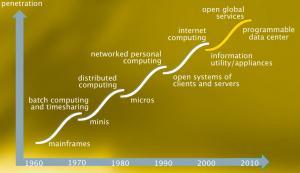In Business, Official Blog, Tech-BLOG, Tech-Forum, Technical
Understanding Java: The Language That Changed Programming Forever
By Author – Rashmita Soge
Java is one of the most influential and widely used programming languages in the world today. Created by James Gosling at Sun Microsystems in 1991, Java was designed with a clear mission — write once, run anywhere. This meant that a program written in Java could run seamlessly across multiple operating systems without needing to be rewritten.
The first public version, Java 1.0, was launched in 1995, marking the beginning of a new era in software development. Later, in 2010, Oracle Corporation acquired Sun Microsystems and took over the stewardship of Java. To support the open-source community, Java was made available under the GNU General Public License (GPL), and Oracle continues to manage its open-source version through OpenJDK.
Today, one of the most popular versions in use is Java 8, known for its efficiency, simplicity, and powerful features.
What is Java?
Java is a general-purpose, class-based, and object-oriented programming language. It is platform-independent, meaning programs can run on any system that supports Java, without modification. Java is also secure, portable, multithreaded, dynamic, and robust, making it an ideal choice for a wide range of applications — from desktop and mobile apps to enterprise and web-based systems.
In essence, Java allows developers to write code once and execute it anywhere, providing unmatched flexibility in today’s multi-platform world.
A Brief History of Java
The journey of Java began when James Gosling and his team — Michael Sheridan and Patrick Naughton — started working on a project called Project Green in 1991. Their goal was to develop a programming language for smart appliances and interactive devices that could deliver high performance, security, and portability.
Initially, the language was named Oak, after the tree outside Gosling’s office. However, due to a trademark conflict, it was later renamed Java. The first version, Java 1.0a2, along with the HotJava browser, was released in 1995 — introducing the world to the power of platform-independent programming.
The team set out some core principles for Java, ensuring that it was:
-
Secure and reliable
-
High performing
-
Portable and architecture-neutral
-
Threaded, interpreted, and dynamic
-
Entirely object-oriented
Over time, Java became the foundation of enterprise software and web technologies, powering millions of applications globally.
How Java Works
To understand Java’s power, it’s important to look at how it functions differently from other languages.
In traditional languages like C or C++, the compiler generates machine-specific code. For instance, a C++ program compiled on Windows will not run on Linux without recompilation.
Java solves this problem through its Java Virtual Machine (JVM). When you write Java code, it is compiled into bytecode instead of platform-specific code. This bytecode runs on the JVM, which acts as an interpreter between the Java program and the underlying operating system.
This process ensures that the same Java program can run on any device or OS that has a JVM installed — whether it’s Windows, macOS, or Linux.
In short, Java follows a compile once, run anywhere model.
Key Features of Java
Here are some of the most important characteristics that make Java a preferred language among developers:
-
Platform Independent – Java programs run on any device that supports the JVM.
-
Object-Oriented – Everything in Java is treated as an object, allowing for modular, reusable, and flexible code.
-
Strongly Typed – Java requires explicit data type declarations, reducing errors.
-
Interpreted and Compiled – Java code is both compiled into bytecode and interpreted by the JVM for faster execution.
-
Automatic Memory Management – The Java Garbage Collector automatically frees up memory by removing unused objects, making the process safer and more efficient.
The Future of Java
Despite being more than two decades old, Java remains one of the most relevant and in-demand programming languages in the world. The continuous updates and strong community support ensure it stays modern and capable.
The Apache Maven build automation tool, widely used in Java-based projects, proves that Java continues to evolve with modern development practices. With Oracle’s ongoing commitment to enhancing Java, newer versions keep introducing improvements in performance, scalability, and developer productivity.
Even with competition from newer languages like .NET, Python, and Kotlin, Java continues to dominate due to its stability, strong security features, and massive ecosystem of frameworks and libraries.
Java’s long history has made it a trusted choice for enterprise-level applications, Android development, and large-scale web systems. Its simplicity, combined with power and reliability, ensures that Java is not going anywhere — it will continue to be a vital part of the programming world for decades to come.
Conclusion
From its humble beginnings in the early 90s to becoming a global standard in software development, Java has proven its worth as a versatile, secure, and efficient programming language.
It not only changed how software is written but also how it is executed across diverse platforms. With continued innovation and community support, Java will remain a cornerstone of modern programming — empowering developers to build reliable, high-performance applications that shape the future of technology.
By Author – Rashmita Soge
Java is a programming language created by James Gosling from Sun Microsystems (Sun) in 1991. The target of Java is to write a program once and then run this program on multiple operating systems. The first publicly available version of Java (Java 1.0) was released in 1995. Sun Microsystems was acquired by the Oracle Corporation in 2010. Oracle has now the steermanship for Java. In 2006 Sun started to make Java available under the GNU General Public License (GPL). Oracle continues this project called OpenJDK. Over time new enhanced versions of Java have been released. The current version of Java is Java 1.8 which is also known as Java 8.
Java is defined by a specification and consists of a programming language, a compiler, core libraries and a runtime (Java virtual machine) The Java runtime allows software developers to write program code in other languages than the Java programming language which still runs on the Java virtual machine. The Java platform is usually associated with the Java virtual machine and the Java core libraries.
What is java?
Java is a General Purpose, class-based, object-oriented, Platform independent, portable, Architecturally neutral, multithreaded, dynamic, distributed, Portable and robust interpreted Programming Language.
It is intended to let application developers “write once, run anywhere” meaning that compiled Java code can run on all platforms that support Java without the need for
History of Java
Java is the brainchild of Java pioneer James Gosling, who traces Javas core idea of, Write Once, Run Anywhere back to work he did in graduate school.
After spending time at IBM, Gosling joined Sun Microsystems in 1984. In 1991, Gosling partnered with Sun colleagues, Michael Sheridan and Patrick Naughton on Project Green, to develop new technology for programming next-generation smart appliances. Gosling, Naughton, and Sheridan set out to develop the project based on certain rules. They were specifically tied to performance, security, and functionality. Those rules were that Java must be:
- Secure and robust
- High performance
- Portable and architecture-neutral, which means it can run on any combination of software and hardware
- Threaded, interpreted, and dynamic
- Object-oriented
Over time, the team added features and refinements that extended the heirloom of C++ and C, resulting in a new language called Oak, named after a tree outside Goslings office.
After efforts to use Oak for interactive television failed to materialize, the technology was re-targeted for the world wide web. The team also began working on a web browser as a demonstration platform.
Because of a trademark conflict, Oak was renamed, Java, and in 1995, Java 1.0a2, along with the browser, name HotJava, was released. The Java language was designed with the following properties:
- Platform independent: Java programs use the Java virtual machine as abstraction and do not access the operating system directly. This makes Java programs highly portable. A Java program (which is standard-compliant and follows certain rules) can run unmodified on all supported platforms, e.g., Windows or Linux.
- Object-orientated programming language: Except the primitive data types, all elements in Java are objects.
- Strongly-typed programming language: Java is strongly-typed, e.g., the types of the used variables must be pre-defined and conversion to other objects is relatively strict, e.g., must be done in most cases by the programmer.
- Interpreted and compiled language: Java source code is transferred into the bytecode format which does not depend on the target platform. These bytecode instructions will be interpreted by the Java Virtual machine (JVM). The JVM contains a so-called Hotspot-Compiler which translates performance critical bytecode instructions into native code instructions.
- Automatic memory management: Java manages the memory allocation and de-allocation for creating new objects. The program does not have direct access to the memory. The so-called garbage collector automatically deletes objects to which no active pointer exists.
How Java Works?
To understand the primary advantage of Java, you’ll have to learn about platforms. In most programming languages, a compiler generates code that can execute on a specific target machine. For example, if you compile a C++ program on a Windows machine, the executable file can be copied to any other machine but it will only run on other Windows machines but never another machine. A platform is determined by the target machine along with its operating system. For earlier languages, language designers needed to create a specialized version of the compiler for every platform. If you wrote a program that you wanted to make available on multiple platforms, you, as the programmer, would have to do quite a bit of additional work.? You would have to create multiple versions of your source code for each platform.
Java succeeded in eliminating the platform issue for high-level programmers because it has reorganized the compile-link-execute sequence at an underlying level of the compiler. Details are complicated but, essentially, the designers of the Java language isolated those programming issues which are dependent on the platform and developed low-level means to abstractly refer to these issues. Consequently, the Java compiler doesn’t create an object file, but instead it creates a bytecode file which is, essentially, an object file for a virtual machine.? In fact, the Java compiler is often called the JVM compiler. To summarize how Java works, think about the compile-link-execute cycle. In earlier programming languages, the cycle is more closely defined as “compile-link then execute”. In Java, the cycle is closer to “compile then link-execute”.
Future of Java
Java is not a legacy programming language, despite its long history. The robust use of Maven, the building tool for Java-based projects, debunks the theory that Java is outdated. Although there are a variety of deployment tools on the market, Apache Maven has by far been one of the largest automation tools developers use to deploy software applications.
With Oracles commitment to Java for the long haul, its not hard to see why Java will always be a part of programming languages for years to come and will remain as the chosen programming language. 2017 will see the release of the eighth version of Java-Java EE 8.
Despite its areas for improvement, and threat from rival programming languages like.NET, Java is here to stay. Oracle has plans for a new version release in the early part of 2017, with new supportive features that will strongly appeal to developers. Javas multitude of strengths as a programming language means its use in the digital world will only solidify. A language that was inherently designed for easy use has proved itself as functional and secure over the course of more than two decades. Developers who appreciate technological changes can also rest assured the tried-and-true language of Java will likely always have a significant place in their toolset.






 In this digital world, we are obsessed with the technology. Technology is changing every second. With the emergence of technology, the threats in the cybersecurity are increasing every day.
In this digital world, we are obsessed with the technology. Technology is changing every second. With the emergence of technology, the threats in the cybersecurity are increasing every day. Threats to organization
Threats to organization Banking, Financial Services and Insurance (BFSI): The BFSI sector is under growing pressure to update its legacy systems to compete with new digital-savvy competitors. The value of the customer data they hold has grown as consumers demand a more convenient and personalized service, but trust is essential. Some 50% of customers would consider switching banks if theirs suffered a cyber-attack, while 47% would “lose complete trust†in them, according to a recent study. A number of major banks around the world have already been subject to high-profile cyber-attacks suggesting that the sector needs to improve its approach to risk. Financial firms should invest in security applications that are able to adapt to the future of banking to ensure comprehensive, around-the-clock security. Shared Ledgers will feature prominently in the future of the BFSI sector, the best-known example of which is Blockchain, which forms the backbone of cryptocurrency Bitcoin. The blockchain is a database that provides a permanent record of transactions. It leaves an undisputed audit trail that can’t be tampered with, meaning it could completely transform security in the BFSI sector.
Banking, Financial Services and Insurance (BFSI): The BFSI sector is under growing pressure to update its legacy systems to compete with new digital-savvy competitors. The value of the customer data they hold has grown as consumers demand a more convenient and personalized service, but trust is essential. Some 50% of customers would consider switching banks if theirs suffered a cyber-attack, while 47% would “lose complete trust†in them, according to a recent study. A number of major banks around the world have already been subject to high-profile cyber-attacks suggesting that the sector needs to improve its approach to risk. Financial firms should invest in security applications that are able to adapt to the future of banking to ensure comprehensive, around-the-clock security. Shared Ledgers will feature prominently in the future of the BFSI sector, the best-known example of which is Blockchain, which forms the backbone of cryptocurrency Bitcoin. The blockchain is a database that provides a permanent record of transactions. It leaves an undisputed audit trail that can’t be tampered with, meaning it could completely transform security in the BFSI sector.

 Research your audience: Designing a logo is not just about creating an appealing visual. Like the overall color scheme and design of your site, your logo sets your brand apart from the competition and shows people that you’re a legitimate business. Logos are a critical part of the modern visual landscape. Throw yourself into the brand. Save all your sketches. Research online. Create mind maps or mood boards. Build a board and tear it apart. Stop with the clichés. Know your customer need. Give him/her a variety of different design to think on. Ask your customer about the message he/she want to convey via the logo. Don’t just be a designer – be a good one. Designing an effective logo is not a quick or easy process. What it requires is through research, thought, care and attention to ensure the final logo design targets the correct market and broadcasts the right message. A poorly designed logo will have a negative effect on the perception of your business; however, a carefully designed logo can transform a business by attracting the right people.
Research your audience: Designing a logo is not just about creating an appealing visual. Like the overall color scheme and design of your site, your logo sets your brand apart from the competition and shows people that you’re a legitimate business. Logos are a critical part of the modern visual landscape. Throw yourself into the brand. Save all your sketches. Research online. Create mind maps or mood boards. Build a board and tear it apart. Stop with the clichés. Know your customer need. Give him/her a variety of different design to think on. Ask your customer about the message he/she want to convey via the logo. Don’t just be a designer – be a good one. Designing an effective logo is not a quick or easy process. What it requires is through research, thought, care and attention to ensure the final logo design targets the correct market and broadcasts the right message. A poorly designed logo will have a negative effect on the perception of your business; however, a carefully designed logo can transform a business by attracting the right people. Once the idea has been explored on paper you should begin to work on the designs using software called Adobe Illustrator, which is a vector-based software program, which means the artwork produced is scalable and will never lose quality. You should continue to explore and experiment with the ideas even during this state, to ensure the idea produced is presented in its best possible light. Use vector shapes in Adobe Illustrator CC to create a logo that looks good onscreen and in print. The best part about vector art is that it scales to any size. It can be a small business card or a large billboards vector art can be resized and it will not lose its quality. Try to know about the golden circle ratio. It will help you to get a better understanding of various designs.
Once the idea has been explored on paper you should begin to work on the designs using software called Adobe Illustrator, which is a vector-based software program, which means the artwork produced is scalable and will never lose quality. You should continue to explore and experiment with the ideas even during this state, to ensure the idea produced is presented in its best possible light. Use vector shapes in Adobe Illustrator CC to create a logo that looks good onscreen and in print. The best part about vector art is that it scales to any size. It can be a small business card or a large billboards vector art can be resized and it will not lose its quality. Try to know about the golden circle ratio. It will help you to get a better understanding of various designs. Designing the Idea and presenting: Once designs are ready to present you should create a PDF document which will display the logo designs created, with images of the designs in real life examples, along with supporting notes explaining the decisions made. We only present designs which we are confident in, and will give you my opinion on which you believe will be most suitable for your client’s business. You should leave the final choice to your client, and if there is any possibility of improvement in design, the design could be improved or modified to better meet the objectives, changes can be made where necessary.
Designing the Idea and presenting: Once designs are ready to present you should create a PDF document which will display the logo designs created, with images of the designs in real life examples, along with supporting notes explaining the decisions made. We only present designs which we are confident in, and will give you my opinion on which you believe will be most suitable for your client’s business. You should leave the final choice to your client, and if there is any possibility of improvement in design, the design could be improved or modified to better meet the objectives, changes can be made where necessary.
